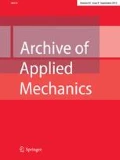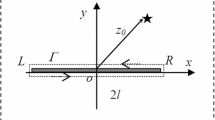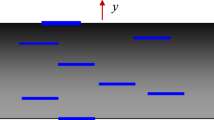Abstract
The inhomogeneous line inclusion problem has various backgrounds in practical application such as graphene sheet-reinforced composites, and hydrogen embrittlement, grain boundary segregation in metallic materials. Due to the long-standing mathematical difficulty, there is no explicit analytical solution obtained except for the thin ellipsoidal inhomogeneity and rigid line inhomogeneity. In this paper, to find the deformation state due to the presence of such kind of elastic inhomogeneities, the inhomogeneous line inclusion problem is tackled in the framework of plane deformation. Firstly, the fundamental solution for a point-wise residual strain is presented and its deformation strain field is derived. By using Green’s function method, the homogeneous line inclusion problem with non-uniform eigenstrain is formulated and an Eshelby tensor-like line inclusion tensor is derived. From the line inclusion concept, the classical edge dislocation is revisited. Also, by virtue of this model, some elementary line homogenous inclusion problems are explored. Secondly, based on the homogeneous line inclusion solution, the inhomogeneous line inclusion problem is formulated using the equivalent eigenstrain principle, and its general solution is derived. Then, an inhomogeneous edge dislocation model is proposed and its analytical solution is presented. Furthermore, to demonstrate the application of the proposed inhomogeneous line inclusion model, a typical thin inclusion under remote load is studied. This study provides a general solution for inhomogeneous thin inclusion problems. The models and their solutions introduced here will also find application in the mechanics of composites analysis, heterogeneous material modeling, etc.













Similar content being viewed by others
References
Aguilar, S., Tabares, R., Serna, C.: Microstructural transformations of dissimilar austenite–ferrite stainless steels welded joints. J. Mater. Phys. Chem. 1, 65–68 (2013)
Atkinson, C.: Some ribbon-like inclusion problems. Int. J. Eng. Sci. 11, 243–266 (1973)
Bakshi, S.R., Lahiri, D., Agarwal, A.: Carbon nanotube reinforced metal matrix composites—a review. Int. Mater. Rev. 55, 41–64 (2010)
Ballarini, R.: An integral-equation approach for rigid line inhomogeneity problems. Int. J. Fract. 33, R23–R26 (1987)
Ballarini, R.: A rigid line inclusion at a bimaterial interface. Eng. Fract. Mech. 37, 1–5 (1990)
Brussat, T.R., Westmann, R.A.: A Westergaard-type stress function for line inclusion problems. Int. J. Solids Struct. 11, 665–677 (1975)
Cantwell, P.R., Tang, M., Dillon, S.J., Luo, J., Rohrer, G.S., Harmer, M.P.: Grain boundary complexions. Acta Mater. 62, 1–48 (2014)
Christensen, R.M.: Mechanics of Composite Materials. Wiley, New York (1979)
Claussen, N., Ruehle, M., Heuer, A. H. (eds.): Advances in ceramics, Vol. 12, p. 352. Science and technology of zirconia II. The American Ceramic Society, Columbus, OH (1984)
Deng, W., Meguid, S.A.: Analysis of conducting rigid inclusion at the interface of two dissimilar piezoelectric materials. J. Appl. Mech. 65, 76–84 (1998)
Du, Y.A., Ismer, L., Rogal, J., Hickel, T., Neugebauer, J., Drautz, R.: First-principles study on the interaction of H interstitials with grain boundaries in \(\alpha \)- and \(\beta \)-Fe. Phys. Rev. B 84, 667–673 (2011)
Dundurs, J., Markenscoff, X.: A Green’s function formulation of anticracks and their interaction with load-induced singularities. J. Appl. Mech. 56, 550–555 (1989)
Eshelby, J.D.: The determination of the elastic field of an ellipsoidal inclusion, and related problems. Proc. R. Soc. Lond. A 241, 376–396 (1957)
Eshelby, J.D.: The elastic field outside an ellipsoidal inclusion. Proc. R. Soc. Lond. A 252, 561–569 (1959)
Frolov, T., Olmsted, D.L., Asta, M., Mishin, Y.: Structural phase transformations in metallic grain boundaries. Nat. Commun. 4, 1899 (2012)
Gorbatikh, L., Lomov, S.V., Verpoest, I.: Original mechanism of failure initiation revealed through modelling of naturally occurring microstructures. J. Mech. Phys. Solids 58, 735–750 (2010)
Hatano, M., Fujinami, M., Arai, K., Fujii, H., Nagumo, M.: Hydrogen embrittlement of austenitic stainless steels revealed by deformation microstructures and strain-induced creation of vacancies. Acta Mater. 67, 342–353 (2014)
Herbig, M., Kuzmina, M., Haase, C., Marceau, R.K.W., Gutierrez-Urrutia, I., Haley, D., Molodov, D.A., Choi, P., Raabe, D.: Grain boundary segregation in Fe–Mn–C twinning-induced plasticity steels studied by correlative electron backscatter diffraction and atom probe tomography. Acta Mater. 83, 37–47 (2015)
Hickel, T., Nazarov, R., McEniry, E.J., Leyson, G., Grabowski, B., Neugebauer, J.: Ab Initio based understanding of the segregation and diffusion mechanisms of hydrogen in steels. J. Met. 66, 1399–1405 (2014)
Hu, J., Shi, Y.N., Sauvage, X., Sha, G., Lu, K.: Grain boundary stability governs hardening and softening in extremely fine nanograined metals. Science 355, 1292–1296 (2017)
Hull, D., Bacon, D.J.: Introduction to Dislocations, 5th edn. Elsevier, Kidlington (2011)
Hurtado, J.A., Dundurs, J., Mura, T.: Lamellar inhomogeneites in a uniform stress field. J. Mech. Phys. Solids 44, 1–21 (1996)
Inglis, C.E.: Stresses in a plate due to the presence of cracks and sharp corners. Inst. Naval Archit. Lond. 55, 219–230 (1913)
Ioakimidis, N.I., Theocaris, P.S.: The second fundamental crack problem and the rigid line inclusion problem in plane elasticity. Acta Mech. 34, 51–61 (1979)
Kaczynski, A., Kozłowski, W.: Thermal stresses in an elastic space with a perfectly rigid flat inclusion under perpendicular heat flow. Int. J. Solids Struct. 46, 1772–1777 (2009)
Kitahara, H., Ueji, R., Tsuji, N., Minamino, Y.: Crystallographic features of lath martensite in low-carbon steel. Acta Mater. 54, 1279–1288 (2006)
Koyama, M., Akiyama, E., Tsuzaki, K.: Hydrogen embrittlement in a Fe–Mn–C ternary twinning-induced plasticity steel. Corros. Sci. 54, 1–4 (2012)
Li, H., Xia, S., Zhou, B., Liu, W.: C–Cr segregation at grain boundary before the carbide nucleation in Alloy 690. Mater. Charact. 66, 68–74 (2012)
Li, Q., Ting, T.C.T.: Line inclusions in anisotropic elastic solids. J. Appl. Mech. 56, 556–563 (1989)
Liddicoat, P.V., Liao, X.Z., Zhao, Y., Zhu, Y., Murashkin, M.Y., Lavernia, E.J., Valiev, R.Z., Ringer, S.P.: Nanostructural hierarchy increases the strength of aluminium alloys. Nat. Commun. 1, 63 (2010)
Ma, L.F.: Fundamental formulation for transformation toughening. Int. J. Solids Struct. 47, 3214–3220 (2010)
Ma, L.F., Korsunsky, A.M.: The principle of equivalent eigenstrain for inhomogeneous inclusion problems. Int. J. Solids Struct. 51, 4477–4484 (2014)
Ma, L.F., Wang, B., Korsunsky, A.M.: Plane deformation of circular inhomogeneous inclusion problems with non-uniform symmetrical dilatational eigenstrain. Mater. Des. 86, 809–817 (2015)
Ma, L.F., Wang, B., Korsunsky, A.M.: Complex variable formulation for a rigid line inclusion interacting with a generalized singularity. Arch. Appl. Mech. 88, 613–627 (2018)
Miracle, D.B.: Metal matrix composites—from science to technological significance. Compos. Sci. Technol. 65, 2526–2540 (2005)
Mura, T.: Micromechanics of Defects in Solids, 2nd edn. Martinus Nijhoff, Dordrecht (1987)
Mura, T.: Inclusion problems. Appl. Mech. Rev. 41, 15–20 (1988)
Mura, T., Shodja, H.M., Hirose, Y.: Inclusion problems. Appl. Mech. Rev. 49, S118–S127 (1996)
Muskhelishvili, N.I.: Some Problems of Mathematical Theory of Elasticity (English translation from the third Russian edition). Noordhoff Ltd., Groningen (1953)
Nemat-Nasser, S., Hori, M.: Micromechanics: Overall properties of heterogeneous materials, 2nd edn. Elsevier, Amsterdam (1999)
Sakaguchi, N., Watanabe, S., Takahashi, H.: Heterogeneous dislocation formation and solute redistribution near grain boundaries in austenitic stainless steel under electron irradiation. Acta Mater. 49, 1129–1137 (2001)
Shodja, H.M., Ojaghnezhad, F.: A general unified treatment of lamellar inhomogeneities. Eng. Fract. Mech. 74, 1499–1510 (2007)
Song, J., Curtin, W.A.: Atomic mechanism and prediction of hydrogen embrittlement in iron. Nat. Mater. 12, 145–151 (2012)
Stankovich, S., Dikin, D.A., Dommett, G.H.B., Kohlhaas, K.M., Zimney, E.J., Stach, E.A., Piner, R.D., Nguyen, S.T., Ruoff, R.S.: Graphene-based composite materials. Nature 442, 282–286 (2006)
Stoller, R.E., Maziasz, P.J., Rowcliffe, A.F., Tanaka, M.P.: Swelling behavior of austenitic stainless steels in a spectrally tailored reactor experiment: implications for near-term fusion machines. J. Nucl. Mater. 155, 1328–1334 (1988)
Tang, M., Carter, W.C., Cannon, R.M.: Diffuse interface model for structural transitions of grain boundaries. Phys. Rev. B 73, 024102 (2006)
Wang, J., Li, Z., Fan, G., Pan, H., Chen, Z., Zhang, D.: Reinforcement with graphene nanosheets in aluminum matrix composites. Scr. Mater. 66, 594–597 (2012)
Wang, Z.Y., Zhang, H.T., Chou, Y.T.: Characteristics of the elastic field of a rigid line inhomogeneity. J. Appl. Mech. 52, 818–822 (1985)
Wu, K.C.: Line inclusions at anisotropic bimaterial interface. Mech. Mater. 10, 173–182 (1990)
Zhou, K., Hoh, H.J., Wang, X., Keer, L.M., Pang, J.H.L., Song, B., Wang, Q.J.: A review of recent works on inclusions. Mech. Mater. 60, 144–158 (2013)
Acknowledgements
This work is partially supported by National Natural Science Foundation of China (Grant No.: 41630634).
Author information
Authors and Affiliations
Corresponding author
Additional information
Publisher's Note
Springer Nature remains neutral with regard to jurisdictional claims in published maps and institutional affiliations.
Rights and permissions
About this article
Cite this article
Ma, L., Qiu, Y., Zhang, Y. et al. General solution for inhomogeneous line inclusion with non-uniform eigenstrain. Arch Appl Mech 89, 1723–1741 (2019). https://doi.org/10.1007/s00419-019-01539-8
Received:
Accepted:
Published:
Issue Date:
DOI: https://doi.org/10.1007/s00419-019-01539-8




